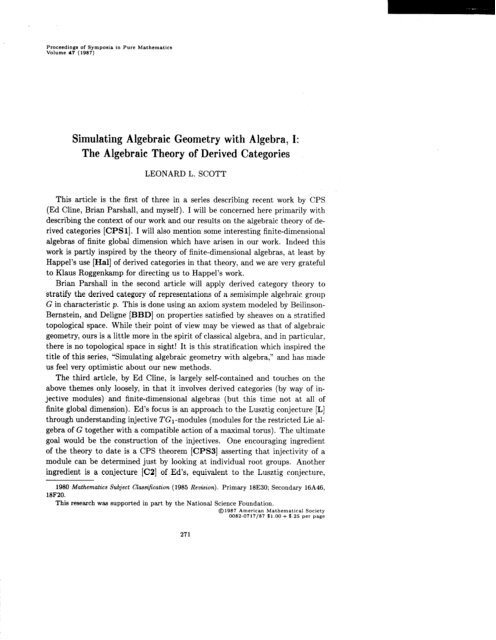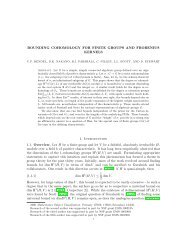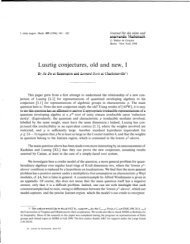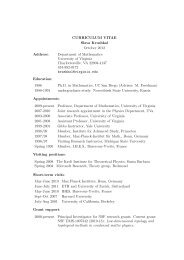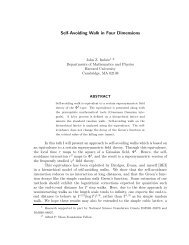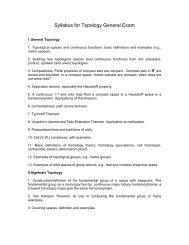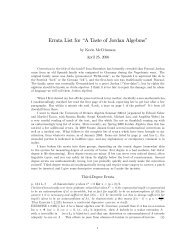Simulating Algebraic Geometry with Algebra, I - University of Virginia
Simulating Algebraic Geometry with Algebra, I - University of Virginia
Simulating Algebraic Geometry with Algebra, I - University of Virginia
You also want an ePaper? Increase the reach of your titles
YUMPU automatically turns print PDFs into web optimized ePapers that Google loves.
Proceedings <strong>of</strong> Symposia in Pure Mathematics<br />
Volume 47 (1987)<br />
<strong>Simulating</strong> <strong><strong>Algebra</strong>ic</strong> <strong>Geometry</strong> <strong>with</strong> <strong>Algebra</strong>, I:<br />
The <strong><strong>Algebra</strong>ic</strong> Theory <strong>of</strong> Derived Categories<br />
LEONARD<br />
L. SCOTT<br />
This article is the first <strong>of</strong> three in a series describing recent work by CPS<br />
(Ed Cline, Brian Parshall, and myself). I will be concerned here primarily <strong>with</strong><br />
describing the context <strong>of</strong> our work and our results on the algebraic theory <strong>of</strong> de-<br />
rived categories [CPSl]. I will also mention some interesting finite-dimensional<br />
algebras <strong>of</strong> finite global dimension which have arisen in our work. Indeed this<br />
work is partly inspired by the theory <strong>of</strong> finite-dimensional algebras, at least by<br />
Happel’s use [Hal] <strong>of</strong> derived categories in that theory, and we are very grateful<br />
to Klaus Roggenkamp for directing us to Happel’s work.<br />
Brian Parshall in the second article will apply derived category theory to<br />
stratify the derived category <strong>of</strong> representations <strong>of</strong> a semisimple algebraic group<br />
G in characteristic p. This is done using an axiom system modeled by Beilinson-<br />
Bernstein, and Deligne [BBD] on properties satisfied by sheaves on a stratified<br />
topological space. While their point <strong>of</strong> view may be viewed as that <strong>of</strong> algebraic<br />
geometry, ours is a little more in the spirit <strong>of</strong> classical algebra, and in particular,<br />
there is no topological space in sight! It is this stratification which inspired the<br />
title <strong>of</strong> this series, “<strong>Simulating</strong> algebraic geometry <strong>with</strong> algebra,” and has made<br />
us feel very optimistic about our new methods.<br />
The third article, by Ed Cline, is largely self-contained and touches on the<br />
above themes only loosely, in that it involves derived categories (by way <strong>of</strong> in-<br />
jective modules) and finite-dimensional algebras (but this time not at all <strong>of</strong><br />
finite global dimension). Ed’s focus is an approach to the Lusztig conjecture [L]<br />
through understanding injective TGi-modules (modules for the restricted Lie al-<br />
gebra <strong>of</strong> G together <strong>with</strong> a compatible action <strong>of</strong> a maximal torus). The ultimate<br />
goal would be the construction <strong>of</strong> the injectives. One encouraging ingredient<br />
<strong>of</strong> the theory to date is a CPS theorem [CPSS] asserting that injectivity <strong>of</strong> a<br />
module can be determined just by looking at individual root groups. Another<br />
ingredient is a conjecture [C2] <strong>of</strong> Ed’s, equivalent to the Lusztig conjecture,<br />
1980 Mathematics Subject Classification (1985 Revision). Primary 18E30; Secondary 16A46,<br />
18F20.<br />
This research wsa supported in part by the National Science Foundation.<br />
01967 American Mathematical Society<br />
0082.0717/87 $1.00 + 8.25 per page<br />
271
272 LEONARD L. SCOTT<br />
which describes how injectives behave under Jantzen translation. There is some<br />
suggestion <strong>of</strong> a Hecke algebra action on injectives here, which ultimately might<br />
easily have a derived category formulation. Finally, Ed discusses some striking<br />
empirical observations he has made [Cl], interpreting in detail certain coefficients<br />
<strong>of</strong> the affine Kazhdan-Lusztig polynomials as dimensions <strong>of</strong> sections <strong>of</strong><br />
injective modules.<br />
Context: The Lusztig conjecture and its characteristic 0 counterpart.<br />
We begin by recalling the Kazhdan-Lusztig conjecture [KLl], which described<br />
the characters <strong>of</strong> the irreducible constituents <strong>of</strong> Verma modules (for<br />
semisimple Lie algebras over C):<br />
chL, = c(-1) +‘)--l(y)Py,w (1) ch My<br />
where the subscripts are an indexing <strong>with</strong> the Weyl group <strong>of</strong> the Verma and<br />
irreducible modules in the “block” associated <strong>with</strong> the trivial module, and the<br />
Py,zo’s are now called Kazhdan-Lusztig polynomials. The “Lusztig conjecture”<br />
[L] is an analogue for the irreducible representations in characteristic p <strong>of</strong> an<br />
algebraic group G. (The Lw’s are still irreducibles in the principal block, the<br />
chM,‘s are essentially still characters <strong>of</strong> Verma modules, and the subscripts<br />
range over values in the affine Weyl group restricted by the “lowest p2-alcove”;<br />
cf. Cline’s article. This restriction has the effect <strong>of</strong> forcing p larger than the<br />
Coxeter number, but there is some feeling that there will someday be versions<br />
which avoid this.)<br />
Kazhdan and Lusztig showed [KL2] that their polynomials Py,,,(q) were<br />
PoincarC polynomials for the new “intersection cohomology theory” <strong>of</strong> Goreski-<br />
McPherson, as adapted by Deligne to algebraic geometry. Deligne showed that<br />
the theory thus obtained satisfied the Weil conjectures, an essential ingredient in<br />
relating it to the Hecke algebra context <strong>of</strong> Kazhdan-Lusztig. (The Hecke algebra<br />
multiplication constants are naturally rational points <strong>of</strong> varieties.) Meanwhile,<br />
David Vogan had observed that, formally, one could view the “true” coefficients<br />
describing the ch L,‘s in terms <strong>of</strong> the ch Mw’s as Poincare polynomials, but using<br />
Ext groups involving the unknown irreducible modules L,. (The observation<br />
also extends to characteristic p [S, An].)<br />
Those <strong>of</strong> us thinking about such things at the time chuckled to ourselves,<br />
“All we need now is something that behaves simultaneously like a topological<br />
space and like the unknown irreducible modules.” Of course when the Kazhdan-<br />
Lusztig conjecture was proved, at the end <strong>of</strong> 1980 by Brylinski-Kashiwara [BK],<br />
and almost at the same time by Beilinson-Bernstein, that was precisely how it<br />
happened!<br />
The Brylinski-Kashiwara pro<strong>of</strong>. The new-to us-ingredient was the<br />
theory <strong>of</strong> D-modules. Of course, Bernstein and Kashiwara had been working<br />
<strong>with</strong> them for years! These are sheaves <strong>of</strong> modules over a sheaf <strong>of</strong> differential
ALGEBRAIC THEORY OF DERIVED CATEGORIES 273<br />
operators. The theory is indeed quite a blend <strong>of</strong> sophisticated algebraic and<br />
topological-analytic<br />
ideas.<br />
The Brylinski-Kashiwara pro<strong>of</strong> may be described schematically as follows:<br />
equivalence<br />
categories<br />
<strong>of</strong><br />
D-modules<br />
(holonomic, RS, . . . )<br />
/ \<br />
equivalence<br />
<strong>of</strong><br />
derived cateoories<br />
&iv constructible sheaves<br />
(constant<br />
on cells)<br />
Here &iv is essentially the principal block for an abelian category generated<br />
by the Verma modules. One ingredient in the pro<strong>of</strong> is showing that this block is<br />
equivalent to a category <strong>of</strong> D-modules satisfying reasonable conditions, including<br />
the conditions that they be holonomic <strong>with</strong> regular singularities. We will not<br />
elaborate on these, except to say that they are natural and make no reference to<br />
the Schubert structure <strong>of</strong> G/B. There is a further condition, however, requiring<br />
that the “support” <strong>of</strong> the D-modules involved be described suitably in terms<br />
<strong>of</strong> Schubert cells (double cosets for B in G, <strong>with</strong> the right action <strong>of</strong> B factored<br />
out).<br />
Now we come to the remarkable part <strong>of</strong> the above diagram. Work <strong>of</strong> Mebkhout<br />
[Me], approached independently by Kashiwara, implies that there is an equiva-<br />
lence <strong>of</strong> derived categories between the (bounded) derived category <strong>of</strong> this cat-<br />
egory <strong>of</strong> D-modules and the corrsponding derived category <strong>of</strong> sheaves, <strong>with</strong> co-<br />
homology constant on Schubert cells, <strong>of</strong> finite-dimensional vector spaces over<br />
C. (Strictly speaking, this is a “relative” derived categ0ry.l Some modern au-<br />
thors prefer to think <strong>of</strong> the Mebkhout equivalence in terms <strong>of</strong> “perverse sheaves”<br />
[BBD], though we do not require these here. I would like to take this opportunity<br />
to thank Herb Clemens for first pointing out to us the implicit role <strong>of</strong><br />
Mebkhout’s work in the Brylinski-Kashiwara pro<strong>of</strong>.)<br />
This equivalence <strong>of</strong> derived categories is by no means induced by an equivalence<br />
<strong>of</strong> categories! When composed <strong>with</strong> the first equivalence <strong>of</strong> categories, in fact,<br />
we find that Verma modules in &riv do not correspond to sheaves at all, but<br />
rather to translations <strong>of</strong> naturally defined sheaves in the derived category. (The<br />
sheaves involved are direct images <strong>of</strong> extensions by zero <strong>of</strong> the constant sheaf C<br />
on a cell, the codimension <strong>of</strong> the latter determining the extent <strong>of</strong> translation.)<br />
The irreducible modules, it turns out, correspond precisely to sheaf complexes<br />
defining the new intersection cohomology theory. The pro<strong>of</strong> is then completed<br />
by appealing to earlier work <strong>of</strong> Kazhdan-Lusztig [KL2], where they calculated<br />
intersection cohomology in Schubert varieties in terms <strong>of</strong> their polynomials. As I<br />
mentioned earlier, this Kazhdan-Lusztig part <strong>of</strong> the argument is quite an event in<br />
itself, requiring results <strong>of</strong> Deligne which allow the Weil conjectures to be applied<br />
to the new intersection cohomology theory.<br />
‘Added in pro<strong>of</strong>: We ignored this distinction at the conference, though it is clear now that<br />
it is important. Also, the “perverse sheaf” formalism is increasingly attractive.
274 LEONARD L. SCOTT<br />
What I wish to focus on, however, is the derived category aspect <strong>of</strong> the pro<strong>of</strong>.<br />
If one ignores the D-modules and Weil conjectures, the pro<strong>of</strong> is still very remarkable:<br />
I know <strong>of</strong> no previous major result established by a nontrivial equivalence<br />
<strong>of</strong> derived categories. I think most mathematicians regarded derived categories<br />
as a homological curiosity, or, at best, a technical convenience. Now they have<br />
made a striking appearance in nature, and must be taken more seriously.<br />
Perhaps it is time for<br />
A quick kindergarten crash course in derived categories. Now every-<br />
one knows that kindergarten children have a tendency to define words in terms<br />
<strong>of</strong> actions. The result is <strong>of</strong>ten ungrammatical, but gets the point across. In this<br />
spirit we have<br />
DEFINITION. A derived category . . . is when you take complexes seriously!<br />
More formally, let A be an abelian category. We shall also assume that A<br />
has enough injectives. (Th’ is is not necessary for parts <strong>of</strong> the theory, while<br />
other parts are best expressed assuming enough projectives.) The objects <strong>of</strong><br />
our derived categories will be complexes K’ <strong>of</strong> A, except that quasi-isomorphic<br />
complexes are identified. A quasi-isomorphism <strong>of</strong> complexes is a map inducing<br />
an isomorphism<br />
on homology.<br />
Derived categories come in various sizes and shapes, the most common called<br />
D+(a D-(4, Db(4, and D(A). These arise from complexes <strong>of</strong> A whose cohomology<br />
is bounded below, bounded above, bounded, and perhaps unbounded<br />
in either direction, respectively. If K’ represents an object in Db(A), it is quasi-<br />
isomorphic to a complex I’ <strong>of</strong> injectives which is bounded below. In this way<br />
O+(A) is equivalent to the category <strong>of</strong> injective complexes bounded below, <strong>with</strong><br />
the maps being homotopy classes <strong>of</strong> maps <strong>of</strong> complexes. (Maps back at the de-<br />
rived category level are the compositions <strong>with</strong> maps <strong>of</strong> complexes obtained by<br />
throwing in formal inverses <strong>of</strong> quasi-isomorphisms, very much like localizing a<br />
ring. Actually, one only needs compositions <strong>of</strong> length two, and the inverse may<br />
appear on the left or the right [Har].)<br />
The reader undoubtedly learned at an early age at least a basic form <strong>of</strong> the<br />
above quasi-isomorphism to an injective complex: the case where K’ is a complex<br />
consisting <strong>of</strong> a single object A <strong>of</strong> A, viewed as a complex concentrated in degree<br />
0. A quasi-isomorphism A * I’ is essentially an injective resolution <strong>of</strong> A. Such<br />
material is presented in a homological algebra course just prior to defining the<br />
notion <strong>of</strong> right derived functors R” F <strong>of</strong> a given functor F: A -+ B , where B is also<br />
an abelian category. Namely, one sets RnF(A) = P(F(I’)), and argues that<br />
this cohomology is well defined in 8. In fact, one shows that the homotopy class<br />
<strong>of</strong> I’, and thus <strong>of</strong> the complex F(T), does not depend on the chosen resolution.<br />
Prom the present<br />
point <strong>of</strong> view, we think <strong>of</strong> this first <strong>of</strong> all as being a consequence<br />
<strong>of</strong> the equivalence <strong>of</strong> the derived category Db(ff) <strong>with</strong> that <strong>of</strong> the homotopy<br />
category <strong>of</strong> injective complexes bounded below. (Two injective resolutions <strong>of</strong> A<br />
are isomorphic in the derived category to A, thus to each other, and thus are<br />
homotopy equivalent. The beauty <strong>of</strong> thinking <strong>of</strong> it this way is that the argument
ALGEBRAIC THEORY OF DERIVED CATEGORIES 275<br />
applies verbatim <strong>with</strong> A replaced by a general K’.) And second, we think <strong>of</strong> the<br />
conclusion not in terms <strong>of</strong> cohomology, but instead as saying that F(I’) is well<br />
defined in D+(B).<br />
The derived category notion <strong>of</strong> a derived functor can now be described: This<br />
functor is denoted RF, and assigns to K’ in D+(A) the object in D+ (8) which<br />
is the complex F(I’) if, as above, I’ is an injective complex isomorphic in D+(A)<br />
to K’. The old notion <strong>of</strong> derived functor on A is recovered by the equation<br />
RnF(A) = P(RF(A))<br />
Thus, as in the theory <strong>of</strong> topological spaces, the individual cohomology terms<br />
are just key invariants <strong>of</strong> something <strong>with</strong> much more substance, the complex<br />
RF(A) in D+(B). (Note that a map <strong>of</strong> complexes preserving homology is by<br />
definition an isomorphism in the derived category; in the topological parallel,<br />
this is a well-known theorem in the homotopy category <strong>of</strong> simply connected<br />
CW complexes, using integral homology.) There is <strong>of</strong> course also a nice formal<br />
aspect <strong>of</strong> the definition: Since RF(A) is a complex, and it makes sense to apply a<br />
derived functor now to a complex, it at least makes sense to compose the derived<br />
functors RF and RG, if G: B -+ C is an additive functor on abelian categories<br />
<strong>with</strong> enough injectives. (Often the result is the derived functor R(G o F) <strong>of</strong> the<br />
composite. The hypotheses <strong>of</strong> the Grothendieck spectral sequence imply this,<br />
and the resulting derived functor conclusion is more desirable than the existence<br />
<strong>of</strong> a spectral sequence-which it implies-if there are further compositions to be<br />
considered.) Finally, it also makes sense to talk about the derived functor, <strong>of</strong> a<br />
functor on complexes not obtained term by term. For example, Hom;l(K’, -)<br />
has a derived functor in the sense <strong>of</strong> the above procedure. (We will not use this<br />
generalization in this paper.)<br />
The derived category has two other structural features we must discuss, translation<br />
and triangles. Translation is the invertible functor T on D+ (A), or Db( A),<br />
etc., which sends K’ to the complex K’[l], where K[m]” = Km+n. In other<br />
words, T shifts K’ to the left by one degree.<br />
Triangles, or more precisely “distinguished triangles,” are the substitute in a<br />
derived category for exact sequences in an abelian category. An example <strong>of</strong> a<br />
triangle is the sequence <strong>of</strong> maps<br />
K’ f, L’ + C’(f) + T(K’)<br />
obtained naturally from the mapping cone C’(f) <strong>of</strong> a map f: K’ + L’ <strong>of</strong> complexes.<br />
All other examples are isomorphic in the derived category to this one,<br />
and that is the usual definition. Rather than recalling the definition <strong>of</strong> a mapping<br />
cone, however, I will give one further important example <strong>of</strong> a triangle: Let<br />
be an exact sequence in A. Form the complex C’ which is A in degree - 1, B<br />
in degree 0, zero in other degrees, and which has the above map A 4 B as<br />
its differential in degree -1. This complex is clearly isomorphic in the derived
276 LEONARD L. SCOTT<br />
category to C, that is, to the complex which is C in degree 0 and zero elsewhere.<br />
However, for this realization C’ <strong>of</strong> C, we have an obvious map C’ -+ T(A). In<br />
this way the above exact sequence in A can naturally be completed to a triangle<br />
in the derived category. (It is also true that any exact sequence <strong>of</strong> complexes<br />
in the usual sense can be completed to a triangle, but the construction is more<br />
complicated. The abelian ctegory C(A) <strong>of</strong> complexes is an integral part <strong>of</strong> the<br />
theory, though it tends to remain in the background.)<br />
So the notion <strong>of</strong> triangle generalizes and substitutes for that <strong>of</strong> an exact<br />
sequence. At this point we encounter a “fearful symmetry,” which challenges<br />
our concept <strong>of</strong> structure in algebra: If the translation operator T is applied to<br />
a triangle, the result is, except for a sign change in one <strong>of</strong> the maps, again a<br />
triangle. So, suppose you have a triangle A -+ B + C + T(A) <strong>of</strong> objects<br />
in A or the derived category. Thinking in terms <strong>of</strong> the above exact sequence<br />
example, we would like to think <strong>of</strong> this as displaying B structurally in terms<br />
<strong>of</strong> two pieces, A and C, <strong>with</strong> C on top <strong>of</strong> A. However, there is also a triangle<br />
B + C + T(A) -+ T(B), so we must also think <strong>of</strong> C in terms <strong>of</strong> two pieces<br />
B and T(A), <strong>with</strong> T(A) on top <strong>of</strong> B. In the first instance C was a piece <strong>of</strong><br />
B, and in the second, B is a piece <strong>of</strong> C. And where A was a bottom piece in<br />
the first instance, its shift plays the role <strong>of</strong> top piece in the second. This is all<br />
somewhat upsetting to our usual Jordan-Holder view <strong>of</strong> the structure <strong>of</strong> things!<br />
Nevertheless, in practice, one can use much <strong>of</strong> the old intuition in all <strong>of</strong> these<br />
situations, and there are technical substitutes in derived categories (and more<br />
generally, in “triangulated categories,” which formalize the additional translation<br />
and triangle structures we have been discussing) for the isomorphism theorems<br />
basic to the structure-theoretic<br />
way <strong>of</strong> thinking.<br />
For the explicit axioms for triangulated categories, see Brian Parshall’s talk<br />
in this series.<br />
Programs for characteristic p. Of course, CPS would like to assimilate the<br />
Brylinski-Kashiwara pro<strong>of</strong> into characteristic p representation theory, in particular<br />
<strong>with</strong> the goal <strong>of</strong> proving Lusztig’s analogous conjecture for the decomposition<br />
<strong>of</strong> Weyl modules. There are various ways to approach this.<br />
This first way is to try and carry over the techniques directly. This was our<br />
first thought, and we were not too successful at it. There are really two steps<br />
here, first replacing the analytic techniques <strong>with</strong> those <strong>of</strong> algebraic geometry in<br />
characteristic 0, and then going from characteristic 0 to characteristic p. We<br />
have learned that Bernstein’s version [Be] <strong>of</strong> the pro<strong>of</strong> does indeed now avoid<br />
the complex analysis. (We are grateful to Pr<strong>of</strong>essor Hotta for this and many<br />
other references on D-modules.)<br />
The above approach is certainly due much further consideration, and we will<br />
surely give it further thought ourselves. But our initial reaction (to not getting<br />
anywhere) was to return to pure algebra [CPSl]. The program here is to understand<br />
and eventually construct the injective modules, <strong>with</strong> the aid <strong>of</strong> clues
ALGEBRAIC THEORY OF DERIVED CATEGORIES 277<br />
supplied by the Lusztig conjecture. Actually, one can get quite far <strong>with</strong> this; see<br />
Ed Cline’s talk in this series.<br />
The approach we now discuss here, however, as continued in Brian Parshall’s<br />
talk, is an intermediate one. We wish to focus on the algebraic issues, derived<br />
categories in particular, raised by the Brylinski-Kashiwara pro<strong>of</strong>. Ideally, one<br />
would only use the D-modules philosophically, and directly approach the all<br />
important equivalence <strong>of</strong> derived categories:<br />
&ii<br />
, ’ b-module; 1<br />
/ 0 ’ (holonomic, RS, . . . FL,<br />
/<br />
/<br />
,<br />
.<br />
/<br />
.<br />
/ equivalence <strong>of</strong><br />
.<br />
/<br />
/ derived categories<br />
constructible<br />
(constant<br />
.<br />
.<br />
.<br />
sheaves<br />
on cells)<br />
Some good references for the algebraic theory <strong>of</strong> derived categories are Verdier,<br />
in SGA 4; [De], Hartshorne’s Residues and Duality [Har], and the modern classic<br />
Asterisque 100 [BBD]. The latter reference in particular gives an extremely<br />
valuable discussion <strong>of</strong> the formalism involved in piecing together two derived<br />
categories (recollement) as if one were the category <strong>of</strong> sheaves on an open set,<br />
and the other on its closed complement, in some topological space.<br />
These references are all geometrically oriented, however, and it was the theory<br />
<strong>of</strong> finite-dimensional algebras (in the spirit <strong>of</strong> Auslander, who participated in this<br />
conference) that supplied for us a key ingredient.<br />
Tilting modules. Here is the original definition, due to Brenner-Butler [BrB]:<br />
Let A be a finite-dimensional algebra, and T a finite-dimensional right A-<br />
module. Then T is a tilting module for A provided the following three conditions<br />
are satisfied:<br />
(1) T has a short projective resolution<br />
(2) Ext’(T, T) = 0,<br />
(3) A has a resolution<br />
O-A+To+Tl+O<br />
by A-modules To, Tl in add T, the category <strong>of</strong> direct summands <strong>of</strong> a direct sum<br />
<strong>of</strong> finitely many copies <strong>of</strong> T.<br />
Happel proved [Hal] the following theorem concerning derived categories,<br />
based on previous work on tilting modules <strong>of</strong> Brenner-Butler, Bongartz, and<br />
Happel-Ringel [BrB, Bon, HaR]: Let T be a tilting module for A, [assume<br />
the global dimension <strong>of</strong> A is finite], and put B = EndA[T]. Then the functor<br />
RHomA(T, -) defines an equivalence <strong>of</strong> derived categories:<br />
@(mod-A)<br />
M @(mod-B).
278 LEONARDL.SCOTT<br />
There are also consequences for global dimension estimates and Grothendieck<br />
groups, but we will discuss them below along <strong>with</strong> a generalization <strong>of</strong> the theorem.<br />
What we wish to make evident now is that this was just the kind <strong>of</strong><br />
concrete algebraic result we needed to get started on our algebraic study <strong>of</strong><br />
derived categories.<br />
The notation mod-#A above for Happel refers to the category <strong>of</strong> finite-dimensional<br />
right A-modules, though that is not essential, and it is convenient to use<br />
the notation in the sequel, which discusses rings, for the category <strong>of</strong> all right<br />
A-modules.<br />
Derived categories and Morita theory. The work I will now describe is<br />
from [CPSl], which gives a crude Morita theory for derived categories. The<br />
inspiration for looking at such issues was, <strong>of</strong> course, the Brylinski-Kashiwara<br />
pro<strong>of</strong>. The numbering <strong>of</strong> results has been chosen to coincide <strong>with</strong> the cited<br />
CPS paper. The notation R +vbF refers the derived <strong>of</strong> as<br />
in (A) then to (A). “dim” below<br />
homological<br />
[Har].<br />
THEOREM. A a and a A-module the<br />
conditions:<br />
T a resolution + + . + + + + where<br />
Pi a generated in =<br />
(ii) T) 0 all integers<br />
(iii) has finite 0 A To . . Tg 0 each a<br />
in T.<br />
B the HomA(T,T), = let A B the<br />
HomA(T, and B A functor T.<br />
(a) functor + has in In<br />
dim F f<br />
(b) Simil&yi the functor + D(A) image in In fact,<br />
5 g.<br />
The functora +,bF and induce mutually equivalences be-<br />
D”(A) and<br />
(d) A Homr,(T, T), T satisfies left analogues (ii), and for<br />
B. the projective pdim, T T is moat g, defined for<br />
in (iii) and one choose g pdim, T as one <strong>of</strong> coume,<br />
f = T).<br />
In more recent [Ha2], Happel the formulation his finitealgebra<br />
result include tilting <strong>with</strong> resolutions longer<br />
length. so, and though our work was by his<br />
preprint and work <strong>of</strong> we still not require finite global<br />
mension assumption. difference lies our application a general<br />
[Har, I, in Hartshorne’s attributed to [Har, p. which<br />
extends functors on to all D(A) in circumstances.<br />
This helps make possible to <strong>with</strong> general
ALGEBRAIC THEORY OF DERIVED CATEGORIES 279<br />
A discussion <strong>of</strong> tilting modules for orders had been begun by Roggenkamp in<br />
an unpublished manuscript [RI.<br />
The next result, although formulated in our context, is indeed just a formal<br />
consequence <strong>of</strong> the pro<strong>of</strong> <strong>of</strong> an earlier result <strong>of</strong> Happel [Hal].<br />
(2.5) COROLLARY (HAPPEL). Let A be a ring, T a tilting module in the<br />
general aenae <strong>of</strong> (2.li, ii, iii), and put B = HomA(T,T). Let A = mod-A,<br />
B = mod-B, and let J = R+9bF:Db(A) + Db(B) be the induced equivalence<br />
<strong>of</strong> (2.1). Then there ia an induced iaomorphiam <strong>of</strong> Grothendieck groups<br />
J: Grot(A) --t Grot( B). Furthermore, if A has finite global dimension then<br />
(~xl7[yI)A = (JWL JW f<br />
B or each [X],[Y] E Grot(A). Here ([X],[Y])4 =<br />
x(RHorn~(X, Y)), the Euler characteristic <strong>of</strong> the Ext groups.<br />
Theorem (2.1) says that (generalized) tilting modules give equivalences <strong>of</strong> de-<br />
rived categories which are in fact derived functors. The theorem below provides<br />
a converse. Again A and B are rings, A = mod-A, B = mod-B, and in addition<br />
we let PA denote the category <strong>of</strong> finitely generated projective right A-modules.<br />
The homotopy category <strong>of</strong> bounded complexes from PA is denoted Kb(P~); it<br />
identifies naturally <strong>with</strong> a full subcategory <strong>of</strong> Db(A). Similar definitions and<br />
remarks<br />
apply <strong>of</strong> course to PB.<br />
(3.2) THEOREM. Let A, PA, B, PB be as above. Let F: A + B be a left exact<br />
additive functor. Assume that R+vbF: Db(ff) + D(B) maps Db(A) into Db(B),<br />
inducing an equivalence <strong>of</strong> triangulated categories, as well as an equivalence <strong>of</strong><br />
Kb(P~) <strong>with</strong> Kb(P~). Then F S HomA(T, -), where T is a (generalized) tilting<br />
. .. ..*<br />
module in the aenae <strong>of</strong> (2.11, 11, 111) <strong>with</strong> B !Z HomA (T, T).<br />
Conclusion. There are two further main consequences <strong>of</strong> our Morita theory<br />
investigation, both partly inadvertent. Nevertheless, their discovery has made<br />
us feel very optimistic about further progress.<br />
The first is precisely the subject <strong>of</strong> Brian Parshall’s continuation <strong>of</strong> this lecture:<br />
A natural question to ask, <strong>with</strong> the above Morita/Tilting theory in hand,<br />
is “What happens if condition (iii) for a generalized tilting module in (2.1) is<br />
dropped” One answer is that instead <strong>of</strong> an equivalence theory for derived<br />
categories, one is led to a stratification theory using the recollement axioms <strong>of</strong><br />
Asterisque 100. In particular we give conditions for topological-style stratifications<br />
at the derived category level for modules over a ring. But our theory<br />
applies especially well to categories <strong>of</strong> rational representations for a semisimple<br />
algebraic group, and we demonstrate stratifications <strong>of</strong> the derived categories here<br />
which bear a remarkable resemblance to those for constructible sheaves in the<br />
Brylinski-Kashiwara pro<strong>of</strong>. As noted in the introduction, this is the source <strong>of</strong><br />
the title <strong>of</strong> this series, “<strong>Simulating</strong> algebraic geometry <strong>with</strong> algebra.”<br />
In the context <strong>of</strong> these algebraic group investigations we have found a huge<br />
new class A <strong>of</strong> finite-dimensional algebras <strong>of</strong> finite global dimension, containing<br />
as their collective module categories all rational representations <strong>of</strong> semisimple
280 LEONARD L. SCOTT<br />
algebraic groups. Morita equivalent versions <strong>of</strong> these algebras have been independently<br />
discovered by Steve Donkin [Don]. These versions include the classical<br />
Schur algebras studied by Schur, Green [G], and Aken-Buchsbaum [AkB]. The<br />
latter pair established the finite global dimension <strong>of</strong> Schur algebras independently<br />
<strong>of</strong> an earlier unpublished pro<strong>of</strong> by Donkin.<br />
We call the algebras in A “quasi-hereditary” because A shares the following<br />
property <strong>with</strong> the class <strong>of</strong> hereditary algebras:<br />
Any A has a nonzero ideal J such that<br />
(1) As a left A-module, J is projective.<br />
(2) HomA(J,A/J) = 0, and J(radA)J = 0. (That is, the composition factors<br />
in J/ rad J do not appear in A/J, and rad J = (rad A) J is an A/J module.<br />
(3) If J # A, then the factor ring A/J belongs to A.<br />
In the hereditary case, one can just take J to be the socle <strong>of</strong> A. This is a<br />
more refined list than I presented at the conference, but perhaps closer to an<br />
axiomatization. Indeed, the above list does recursively axiomatize some class<br />
<strong>of</strong> finite-dimensional algebras if, in (3), we replace “belongs to A” by “satisfies<br />
these axioms (l), (2), and (3).” As <strong>of</strong> this writing, it seems reasonable to label<br />
these the algebras <strong>of</strong> interest, and we give them the name “quasi-hereditary.”<br />
Using Theorem (2.1) in Brian Parshall’s talk [CPSB, (3.1)] one can show these<br />
algebras all have finite global dimension. The cited theorem gives a derived category<br />
embedding Llb(A/ J-mod) + Db(A-mod), which implies the Ext groups<br />
<strong>of</strong> A/J modules can be computed in A-mod. This can also be used to show<br />
that the axioms have left-right symmetry. (Taking duals, we get a similar statement<br />
about Ext for right modules. Now the issue is showing Exti(A/J, S) = 0<br />
for S any simple right A-module which is not an A/J module. But clearly<br />
Ext;(S*, (A/J)*) is a summand <strong>of</strong> Exti(J/rad J, (A/J)*) = Exti(J, (A/J)*),<br />
using the derived category embedding for left A/J-modules and the injectivity<br />
<strong>of</strong> (A/J)*. The latter Ext group is <strong>of</strong> course zero by the projectivity <strong>of</strong> J.)<br />
Notice the layering in the left ideal structure which is imposed by the above<br />
axioms. This reflects at a ring-theoretic level the stratification <strong>of</strong> their module<br />
derived categories. To illustrate the left ideal structure, and the difference<br />
between hereditary and quasi-hereditary in simple cases, we give below the decomposition<br />
<strong>of</strong> the left regular representation in schematic form <strong>of</strong> two algebras.<br />
Each has exactly two irreducible modules, labeled a and b, <strong>of</strong> dimension one.<br />
Hereditary<br />
Quasi-hereditary<br />
REFERENCES<br />
[An] H. H. Andersen, An inversion formula for the Kazhdan-Luaztig polynomials for afine<br />
Weyl groupq Aarhus Preprint 31, 1982; Adv. in Math. (to appear).<br />
[AkB] L. Aken and D. Buchsbaum, Characteristic-free representation theory <strong>of</strong> the general<br />
linear group, Preprint.<br />
[Be] J. Bernstein, Algekaic theory <strong>of</strong> D-modules, Preprint.
ALGEBRAICTHEORYOFDERIVEDCATEGORIES 281<br />
[Bon] K. Bongartz, Tilted algebras, Lecture Notes in Math., vol. 903, Springer-Verlag, 1982,<br />
pp. 26-38.<br />
[BrB] S. Brenner and M. C. R. Butler, Generalizations <strong>of</strong> the Bernstein-Gelfand-Ponomarov<br />
rejection functors, Proc. Internat. Conf. on Representations <strong>of</strong> <strong>Algebra</strong>s, Lecture Notes in<br />
Math., vol. 832, Springer-Verlag, 1980, 103-169.<br />
[BBD] A. Beilinson, J. Bernstein, and P. Deligne, Analyse et topologie sw les espaces sing&em,<br />
Asterisque, no. 100, Sot. Math. France, Paris, 1982.<br />
[BK] J. Brylinski and M. Kashiwara, Kazhdan-Lwztig conjecture and holonomic JYS~.WZJ,<br />
Invent. Math. 64 (1981), 387-410.<br />
[Cl] E. Cline, On injective modules for infinitesimal algebraic groups. II, Preprint.<br />
[C2] -, Z+anslation fun&or and Hecke algebra actions, unpublished informal notes.<br />
[CPSl] E. Cline, B. Parshall, and L. Scott, Derived categories and Morita theory, J. <strong>Algebra</strong><br />
104 (1986), 397-409.<br />
[CPS2] -, <strong><strong>Algebra</strong>ic</strong> stratification in representation categories, J. <strong>Algebra</strong> (to appear).<br />
[CPS3] -, On injective modules for infinitesimal algebraic groups I, J. London Math. Sot.<br />
(2) 31 (1985), 277-291.<br />
[De] P. Deligne, <strong>with</strong> an appendix by J. Verdier, Cat6gories dhivtes (SGA 4;), Lecture<br />
Notes in Math., vol. 569, Springer-Verlag, 1977.<br />
[Don] S. Donkin, On S&UT algebras and related algebras. I, II, J. <strong>Algebra</strong> 104 (1986), 310-<br />
328; J. <strong>Algebra</strong> (to appear).<br />
[G] J. A. Green, Polynomial representations <strong>of</strong> Gl,, Lecture Notes in Math., vol. 830,<br />
Springer-Verlag, 1980.<br />
(Har] R. Hartshorne, Residues and duality, Lecture Notes in Math., vol. 20, Springer-Verlag,<br />
1966.<br />
[Hal] D. Happel, Triangulated categories in representation theory <strong>of</strong> finite dimensional algebras,<br />
Preprint, January 1985.<br />
[Ha21 -, On the derived category <strong>of</strong> a finite-dimensional algebra, Preprint (apparently a<br />
revision <strong>of</strong> [Hal]).<br />
[HaR] D. Happel and C. Ringel, Tilted algebras, Trans. Amer. Math. Sot. 274 (1982),<br />
33sb443.<br />
[KLl] D. Kazhdan and G. Lusztig, Representations <strong>of</strong> Coseter groups and Hecke algebras,<br />
Invent. Math. 63 (1979), 165-184.<br />
[KL2] -, Schubert varieties and Poincart duality, Proc. Sympos. Pure Math., vol. 36,<br />
Amer. Math. Sot., Providence, R.I., 1980, pp. 185-203.<br />
[L] G. Lusztig, Some problems in the representation theory <strong>of</strong> finite Chevalley groups, Proc.<br />
Sympos. Pure Math., vol. 37, Amer. Math. Sot., Providence, R.I., 1980, pp. 313-317.<br />
[Me] 2. Mebkhout, Une equivalence de categories et une autre equivalence de categories, Compositio<br />
Math. 51 (1984), 5142, 63-88.<br />
(R] K. Roggenkamp, Tilted orders and order8 <strong>of</strong> finite global dimension, Preprint.<br />
[S] L. Scott, RepreJen&OnJ in characteristic p, Proc. Sympos. Pure Math., vol. 37, Amer.<br />
Math. Sot., Providence, R.I., 1980, pp. 319-331.<br />
UNIVERSITY OF VIRGINIA.CHARLOTTESVILLE


